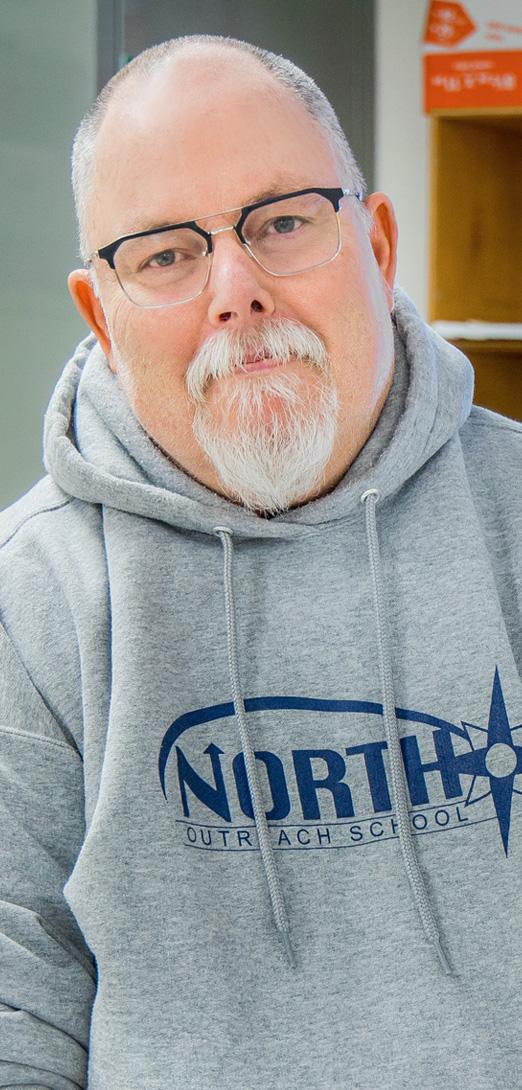
Brittney Lyon
Location– Chipewyan Lake School, Chipewyan Lake
Teaching experience– 3 years
Time in current setting– 2 years
"It's so quiet."
Those three words are how Brittney Lyon describes what it’s like when she steps outside her home in the evening. Sure, she might hear the odd sound—a far-off ATV, a barking dog or water lapping against the nearby lakeshore—but what she mostly hears is profound silence.
This tranquillity is one of the perks of teaching at one of the most isolated schools in Alberta.
“I knew the minute I got my degree that I was not going to work in Edmonton or Calgary or Red Deer,” Lyon says. “I did not want a city. It’s not my dream in life.”
The community of Chipewyan Lake (not to be confused with Fort Chipewyan) lies 110 kilometres straight north of Wabasca, which is itself a remote outpost located 120 kilometres northeast of Slave Lake. Chip, as locals call it, is a two-hour drive on a temperamental gravel road.
A network of casually arranged, unpaved roads mostly skirt the southern shore of Chipewyan Lake. The community of Chipewyan Lake has no services of any kind. There’s no grocery store or convenience store. No gas station. No hotel, restaurant, library or community centre. Besides the nine-room school, there’s a scattering of houses for the roughly 80 residents, a band office for the Bigstone Cree Nation, a shop for the Municipal District of Opportunity and a water treatment plant. There is also a landing strip that airplanes and helicopters can access in emergencies.
The school has three classrooms, a library, a front office, a principal’s office, a staff room, a kitchen and a full-sized gym. Its six staff include the principal/teacher, a second teacher, an educational assistant, a Cree language instructor, a secretary and a cook/custodian.
Remote teaching
The school’s 25 students are split into two groups: K–4 and 5–9. There are also four high school students who use the school to remotely attend Northland School Division’s online school.
Lyon is a third-year teacher. She taught for a year in Fort Chipewyan, then switched to Chipewyan Lake because of its year-round road access. At 26, Lyon is also the school’s principal.
Lyon teaches the 5–9 cohort. While varied in age, these students also present with a wide range of academic abilities, which Lyon manages through a lot of group work.
“Ready for anything” is Lyon’s motto. She says that her teaching assignment calls for a sense of adventure and relentless flexibility. Teachers must be attuned to what the students can handle and be willing to adjust on the fly to avoid pushing students beyond their limits.
“When you push, you lose them,” Lyon says. “The relationship means everything to these kids. If you can’t build that relationship, they do not tolerate or respect you and they stop coming.”
To Lyon’s students, Edmonton is unbelievably huge. Some of them have never travelled beyond the provincial capital, and they love hearing and learning about the broader world.
“It’s just a really nice feeling that kids get so excited about the little things,” Lyon says.
Among her challenges as a teacher and administrator is accommodating kids with special needs because the school has limited resources and expertise on-site. Services like speech and occupational therapy are delivered virtually. And when she needs a substitute, she relies on noncertificated community members as there are no certificated subs available in the area.
Northland School Division has three pedagogical experts who regularly visit schools to support the teachers. One of those is Crystal Colville. She said that planning is one of the keys to living and teaching in a remote location.
“You really have to plan in advance to make sure that you have whatever you’re going to need for the kids or yourself,” she said. “You can’t just run to the store on a Tuesday night.”
Mindset is another key. It helps to be self-reliant with hobbies and interests, as well as willing to be active in the local community.
“That really seems to help our teachers—when they can get involved,” Colville said.
The division ensures that its remote teachers are well supported. Colville encourages teachers to “come for the adventure and see what’s there.”
“It’s definitely a once-in-a-lifetime opportunity and definitely worth doing.”
Remote living
Within a stone’s throw of the school sit two houses owned by the Northland School Division. One, a split level, is a duplex containing two self-contained suites. Lyon occupies the upper suite while the lower one is reserved for visiting school division officials. Next door is a three-bedroom mobile home that’s occupied by the second teacher. Both houses provide a spectacular view of the nearby lake.
The nearest services are in Wabasca, a two-hour drive when the road is passable, which it isn’t during wet weather. Outings such as grocery runs and medical appointments consume an entire day. Lyon makes it out to Slave Lake or Edmonton about two weekends a month, depending on what she needs for the school or her household.
She’d eventually like to move up to a larger centre with more ready access to medical services, but not a major city. Something like Wabasca or Calling Lake would fit the bill.
“I just really enjoy this life ... the isolation,” Lyon says. “And it’s the kids. I know that every teacher says all the time that it’s the kids, but I probably wouldn’t continue living in the isolation that I do if there weren’t really great kids here. These kids here are truly incredible.”
Recruitment an issue for remote schoolsFinding teachers is an ongoing challenge for rural jurisdictions like Northland School Division, which has 1,700 students in 19 schools located throughout the northern half of the province. “Like other rural school divisions, we struggle with recruitment, so I have to focus on what we offer,” said Krista Veitch, Northland’s associate superintendent of human resources. The division’s offerings include schools that are located near mountains, lakes and rivers, updated staff housing, small class sizes and two financial assistance programs that help educators advance their careers. One such program pays for educational assistants to earn their teaching degrees if they return to their home school as a teacher. The other program provides 80 per cent tuition reimbursement to teachers who further their education, such as through a masters or PhD program. “The teachers who come here tend to stay,” Veitch says, “because of the support they receive and the relationships they form in their communities.” The most northerly school in Alberta is Upper Hay River School, located in Meander River, alongside Highway 35, 73 kilometres north of High Level. Northern student teacher bursary As an incentive to attract teachers to northern locations, the province offers the Northern Student Teacher Bursary, which provides students with $18,000 over two years in exchange for a commitment to spend three years teaching full-time in northern Alberta. Details are available at https://www.alberta.ca/northern-student-teacher-bursary. –Government of Alberta |



